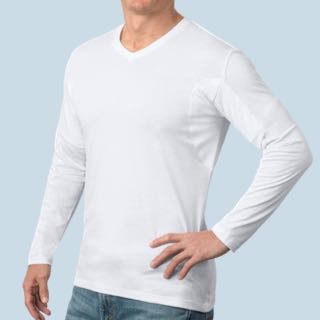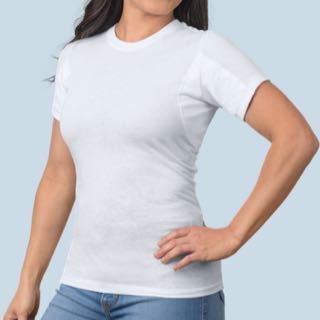Can You Stop Underarm Sweating Permanently?
Excessive underarm sweat is more than a minor inconvenience. It’s a diagnosable medical condition known as axillary hyperhidrosis. When left untreated, hyperhidrosis can control every aspect of your life — from what you wear to your social calendar or your career. Basic treatments just don’t cut it when you have this condition. At a certain point, you start wondering how to stop underarm sweating permanently — or if that’s even possible at all.
In this blog post, we’ll get to the bottom of whether or not you can stop underarm sweat for good. We’ll look at all axillary hyperhidrosis therapies and rank them in order of success rate, so you know exactly what works for the majority and what doesn’t.
Is There a Way to Stop Underarm Sweating Permanently?
Very few treatments are effective at stopping underarm sweating permanently. Most solutions are temporary, or require repeated treatments to keep sweat away. Even sweat gland removal surgery, the most extreme sweat management procedure, doesn’t work for everyone.
Because it’s impossible to know how a procedure or medication will affect you personally, it’s important to look at all of your options objectively and understand what's available. Here are 10 remedies that could help you stop excessive underarm sweat:
- Regular undershirts
- Thompson Tee sweat proof undershirts
- Antiperspirants
- Diet and exercises
- Home remedies
- Hyperhidrosis medications
- Ionotophoresis
- Botox injections
- miraDry
- ETS surgery and sweat gland removal
10 Treatments to Stop Underarm Sweat
Let's dive deeper into the effectiveness of our above recommendations for axillary hyperhidrosis.
1. Regular Undershirts
It doesn’t take rocket science to figure out that regular undershirts suck at stopping sweat from staining your clothes. And they don’t prevent you from sweating permanently.
If you sweat heavily, you already know that a basic undershirt doesn’t work.
But what’s the actual success rate of regular undershirts?
We asked our social media followers how long a regular undershirt prevents sweat stains. 82 percent of respondents said that a regular undershirt lasts less than one hour! Only 18 percent said that a regular undershirt works for several hours to an entire day.
Conclusion: Don’t waste your time. Regular undershirts do very little if you have axillary hyperhidrosis. Time to bring out the big guns.
2. Thompson Tee Sweat Proof Undershirts
The Thompson Tee is a sweat proof undershirt, available in men's and women's styles, is 100 percent guaranteed to prevent underarm sweat from ruining your shirt.
Unlike regular undershirts, the Thompson Tee is made with patented Hydro-Shield technology. The built-in armpit sweat pads absorb perspiration and release it into the air as vapor.
Thompson Tees are a fan-favorite among the hyperhidrosis community, and trusted by thousands of people struggling with armpit sweat. One reviewer says, "As a person that suffers from hyperhidrosis, this product changed my life!" And another happy customer mentioned "I bought one shirt after ALL other methods of controlling hyperhidrosis had failed. I could not believe how well Thompson Tee worked!"
Conclusion: While this sweat proof undershirt won’t permanently stop underarm sweat, it will put an end to underarm sweat stains and ruined clothing, and help you feel more comfortable and confident than ever before. Try it risk-free today!
3. Antiperspirants
Aside from an undershirt, antiperspirants are usually the first line of defense against sweat. Before graduating to more extreme treatments, make sure to experiment with antiperspirants — not just deodorants.
How can you tell the difference between an antiperspirant vs. a deodorant? Check the ingredients. Antiperspirants contain some form of aluminum — the only chemical that is scientifically proven to stop underarm sweat. Aluminum zirconium and aluminum chloride hexahydrate are two of the most common aluminum compounds found in antiperspirant.
Most over-the-counter antiperspirants range from 12-25 percent aluminum concentration. You can get prescription antiperspirant at strengths of 26-30 percent. Check the power of your antiperspirant and increase it if it's not working.
What are the best results you can expect from an antiperspirant alone? In an ideal scenario, antiperspirant keeps sweat away for seven to 12 days after you’ve applied it consistently for a few weeks. However, after surveying our customers on social media, 65 percent said that antiperspirant keeps sweat away for less than an hour. 35 percent said that it keeps sweat away for several hours to one day.
Conclusion: Antiperspirant works well, but for best results, combine with another treatment (such as a sweat proof shirt).
4. Diet and Exercise
Some sources say that adjusting your diet and exercising more can make you sweat less. But can it stop your underarm sweat permanently?
Studies show that dieting has little impact on the amount that you sweat. While eating spicy foods, caffeine, alcohol and vegetables like cabbage or broccoli make your sweating worse, eliminating these foods from your diet will not cure axillary hyperhidrosis.
Exercising more could help reduce the amount you sweat, but only by 50 percent at best — and just if you’re overweight or obese.
In a study of 28 participants, scientists tested the effect of body fat and weight on sweat using stationary bikes. They found that body fat only accounted for one to two percent of the sweat generated while heat production accounted for 50 percent. Those with more body weight heated up quicker than those with less weight and therefore sweat more in a shorter period.
Conclusion: If you’re overweight or obese, shedding a few pounds could help you reduce sweat. But if you’re already a healthy weight and are looking to cure hyperhidrosis, dropping a few pounds isn’t a safe treatment method. Reducing your body fat percentage could help, but only by 1 to 2 percent.
5. Home Remedies
The success rate of home remedies is challenging to measure. While some people claim that natural astringents, potatoes, lemon juice and baking soda have helped them sweat less, there’s no evidence showing that it stops underarm sweat permanently. Most of the time these remedies require persistence to see a difference long term.
There are no concrete statistics about the effectiveness of home remedies. They work on a case-by-case basis. While some people swear by them, others say they’re useless.
Conclusion: Try home remedies at your own risk — your mileage may vary.
6. Hyperhidrosis Medications
The most commonly prescribed oral medications for hyperhidrosis are anticholinergics.
Anticholinergics block chemicals that allow specific nerves to communicate with one another, decreasing how much your entire body sweats.
In a 2012 study, scientists found that anticholinergics were 75 percent effective at reducing but not eliminating sweat in people with hyperhidrosis.
While beta-blockers are also occasionally recommended for treating hyperhidrosis, their primary purpose is to cure high blood pressure by slowing your heart rate. A side effect of this is decreased sweating. Because reduced sweating is a secondary use, there's not enough data to describe the effectiveness of beta blockers on hyperhidrosis.
Conclusion: Talk to your doctor about anticholinergics. Success isn't guaranteed, but you may get lucky.
7. Iontophoresis
In general, surgery and outpatient treatments are the only hyperhidrosis treatments that can prevent sweating permanently. However, the success rates vary and side effects are highly likely.
Iontophoresis is the process of delivering mild electric currents through your skin while your body part is submerged in water. Studies show it’s 81 percent effective at stopping sweat temporarily.
Iontophoresis for hyperhidrosis requires seven 20 to 30-minute treatment sessions over a four-week period. After seven weeks, sweating stops for a few weeks or months and the returns. You can either buy an iontophoresis machine for $500-$700 and administer the treatment yourself or get treated by a doctor for a few hundred dollars more.
Side effects of this treatment include bruising, blisters, mild burning, moderate thickening of the skin and itchiness of the treated area.
Conclusion: This treatment takes commitment. Be prepared to wait four weeks before you see any results — if you see any results. Iontophoresis doesn’t work for 20% of people.
8. Botox Injections
Botox is an injection that prevents underarm sweating by blocking the neurotransmission from sympathetic nerves to the skin. It’s approximately 82-87 percent effective.
Once you receive a Botox injection, you notice reduced sweating about two to four days later. These results last about four to six months. For permanently decreased sweating, you must get repeat injections once you notice sweat returning.
Conclusion: Botox injections are expensive to maintain, about $1,000-$5,000 per session and there's a 20 percent chance it won't work for you at all.
9. miraDry
miraDry is a laser treatment for hyperhidrosis. It heats your sweat glands to make them inactive. This treatment is relatively new as the FDA cleared it in 2015.
Although miraDry claims that it permanently stops sweating since it “turns off” your sweat glands, it only reduces sweat by 82 percent on average. The procedure is reportedly 83-90 percent effective.
After the treatment, your underarms will be completely dry for 2-3 weeks. After 2-3 weeks, some sweat will return. Doctors recommend doing two to three miraDry treatments spaced three months apart. The only drawback to this treatment is that it’s pricey: $2,500 - $3,000 for two treatments.
Conclusion: Although expensive, miraDry can be effective at permanently stopping underarm sweat.
10. ETS Surgery and Sweat Gland Removal
Endoscopic thoracic sympathectomy or ETS surgery aims to stop sweat by destroying a nerve in the upper thoracic region of your spine.
This surgery is the most invasive axillary hyperhidrosis treatment and is no longer recommended as a treatment option. The side effects of ETS can be severe: potential nerve damage and compensatory sweating.
While risky, sweat gland removal is the only way to stop underarm sweating permanently. However, this treatment is expensive and also not recommended.
While you’re under anesthesia, a surgeon makes a small incision above and under your armpit then suctions and scrapes away your sweat glands.
Side effects of sweat gland removal include compensatory sweating and scarring.
Conclusion: ETS and sweat gland removal surgeries are risky and no longer recommended to treat excessive sweating.
How to Evaluate Sweating Treatments
One of the biggest mistakes you can make when evaluating remedies is to hastily decide on a treatment. Instead, follow these steps:
Try Over-The-Counter Treatments First
Rule out the gentlest options before you move onto stronger ones. Start with regular antiperspirants and work your way up to prescription or clinical-strength. You may also want to dabble in home remedies like natural astringents and teas.
If sweat stains are your primary pain point, try the Thompson Tee sweat proof undershirt. It's a non-toxic, non-invasive way to prevent sweat from staining your shirt.
Talk To Your Doctor About Next Steps
Once you’ve ruled out all over-the-counter options, talk to your doctor about your options: prescription, outpatient and surgical treatments.
If your doctor immediately pushes you toward an invasive treatment like ETS surgery or gland removal, you might want to get a second opinion. Invasive therapies tend to have the most adverse side effects, as our co-founder Randy Choi found.
Do Your Research
Before you decide on a treatment, do your research. Make sure you read about what each regimen entails, recovery time, side effects and success rates.
We hope these tips will help you determine the best course of action to combat excessive armpit sweat!

